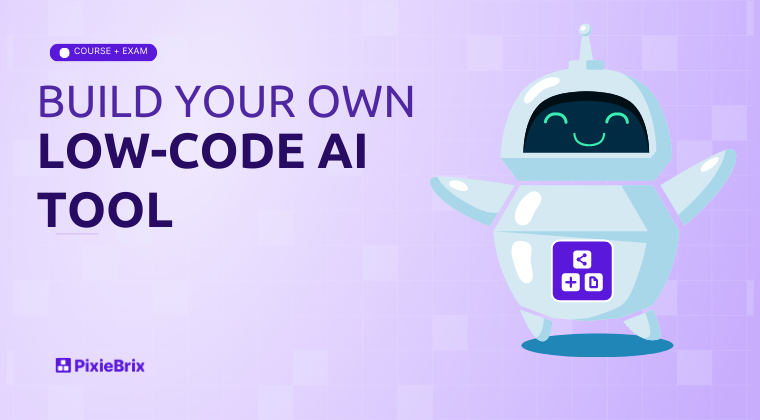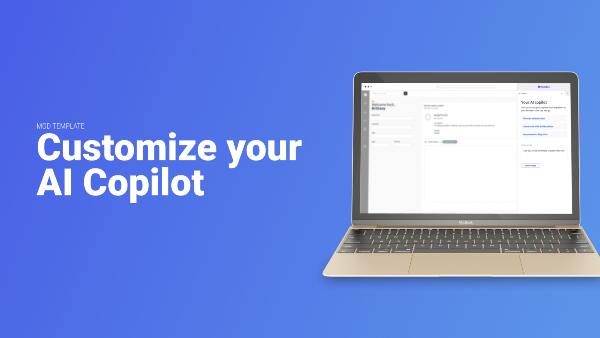What Are Low-Code AI Tools + How to Build Your Own

Diving into low-code AI without the right information and tools can feel pretty daunting. But what if we told you there's a magical shortcut that enables you to get educated fast and build your own AI solutions, even if your last encounter with 'code' was cracking the secret message in a cereal box?
The shortcut is, of course, PixieBrix and our new AI certification.
With these two things, you, too, can harness the power of AI, whether you’re simply looking to automate daily tasks or build your very own digital butler.
In this blog post, we delve into low-code AI tools, how to build your own, our new AI certification, and examples of AI tools built using PixieBrix. Let’s roll!
You can also start building immediately with our customizable mod templates.
What are low-code AI tools or platforms?
Low-code AI tools (sometimes called “no-code AI tools”) let people create and use artificial intelligence (AI) solutions without writing complex code. Think of it like building a Lego structure; you pick and place blocks based on your needs without making each block from scratch.
These platforms basically let you become your own AI app developer, even if you don’t have a degree in software engineering, and enable more people to tap into the power of AI. You don’t even have to use them to build a whole app, though; you can use them to build AI workflows into your daily work or simplify small processes.
PixieBrix is a low-code tool that enables people to use “bricks” to build productivity tools of all sorts, including tools that rely on AI solutions like ChatGPT. You can use PixieBrix to build your own low-code AI tool. See all the tools, or “mods,” our community has made using PixieBrix in our Marketplace.
Why it’s important to get educated in low-code AI
Stay competitive in the job market
Whether you’re a Robotic Processes Automation (RPA) developer or just a human interested in building AI tools, learning low-code AI will help you get ahead in your chosen career.
Brittany Joiner, Head of Developer Relations at PixieBrix says it best: “AI isn't going to take over your job, but people using AI will.”
Joiner also adds, “Because of that, it's important to embrace it and get comfortable with learning how to use it and build with it because it doesn't require years of engineering or developer experience to do that anymore!”
Need more convincing? According to Forbes Advisor, a staggering 97% of business owners believe ChatGPT will help their business. And as AI becomes more integrated into business processes, there is a growing demand for AI support roles.
In 2022, 35% of businesses hired data engineers, and 39% of businesses hired software engineers for AI-related positions, according to McKinsey. That number is only going to continue to grow.
Increase your economic opportunities
Is this too obvious to say out loud? We’re saying it anyway.
The market for AI-driven solutions is growing incredibly quickly, and people with low-code skills can tap into it early. Whether creating new apps, optimizing business processes, or offering consultancy services, you can make money with these skills!
The AI market is projected to reach $407 billion by 2027. In 2022 alone, it grew by $86.9 billion. Furthermore, the U.S. expects AI to increase its GDP by 21% by 2030.
Want a piece of this pie? Getting into low-code AI now is like catching a train gathering speed. The train has already left the station, but the earlier you get on, the more destinations you experience (that is, if destinations are money-making opportunities).
How to build your own low-code AI tool with PixieBrix
If you really want to dive deep into building low-code AI tools, you should consider taking our PixieBrix AI certification course. But here’s a high-level overview of the process:
- Set up your PixieBrix account
- Go to the Page Editor from your Chrome Dev Tools
- Choose a starter brick, like a button on a page, or a keyboard shortcut
- Add various bricks to scrape from a page, get info from an API, or collect user input
- Add the ChatGPT brick to send a prompt to AI
- Display the response from AI, or inject it into your page
- Share your creation with colleagues, friends, or the PixieBrix community!
And voila! You’ve created your first low-code AI tool.
Examples of low-code AI tools made using PixieBrix
The main low-code AI tool we’ve made using PixieBrix (also the one we’re MOST proud of *holding back tears*) is called AI Copilot.
Build your own AI Copilot to run on any webpage you need.

AI Copilot enhances your ChatGPT experience and makes it more efficient by storing and allowing you to access your frequently used prompts directly from any webpage without the need to copy/paste or search extensively. Though you can customize your prompts to your heart’s content, the tool also offers a variety of preset prompt categories for people in professions like marketing, HR, sales, and more.
Watch this short explainer video to see how it works:
Our community has also created a bunch of super cool ChatGPT-powered “mods” that you can view and test out in our Marketplace. They include:
- ChatGPT-3 OOO/WFH Email Assistant: automate the process of requesting Out Of Office or Work From Home arrangements
- Writing Assist: your very own writing assistant, available on Chrome for convenient access wherever you write
- Tip-of-the-Tongue: Reverse Word Lookup with ChatGPT: Look up the name of a concept or word by describing it
- And more!

Introducing the PixieBrix + AI Certification
Want to build your own low-code AI tool? PixieBrix has created an excellent free course for you to start with.
In this course, you’ll not only develop your competitive edge with AI; you’ll also get to:
- Explore the endless possibilities of RPA + AI and dream up new use cases for yourself
- Deep dive on the PixieBrix AI Copilot mod
- Become an expert on how to build your own PixieBrix tools that integrate with ChatGPT
- Learn how to customize pre-existing PixieBrix low-code mods without starting from scratch
- Learn tips on AI prompting within PixieBrix
- Share your low-code AI PixieBrix creation with the world
Quick note: Don’t cancel your weekend plans. This course is just a couple of hours long and includes a 10-question quiz. Plus, you’ll get a snazzy new badge for your LinkedIn profile advertising your low-code AI skills to the world.
So what are you waiting for? Take your first step towards your low-code AI journey now!
